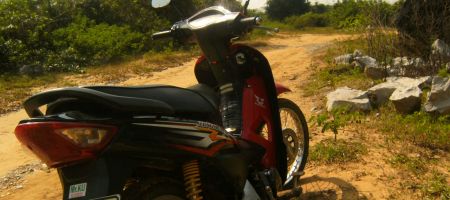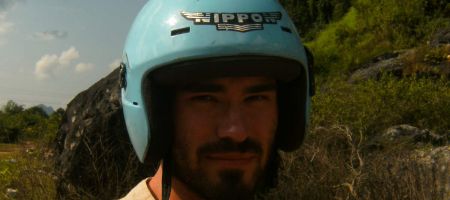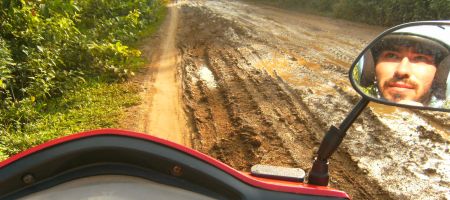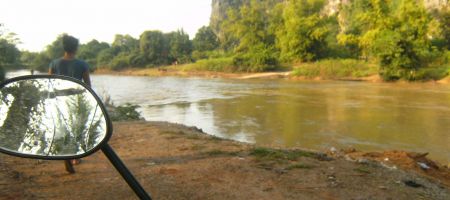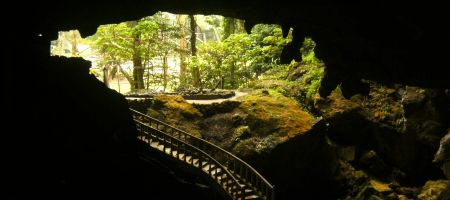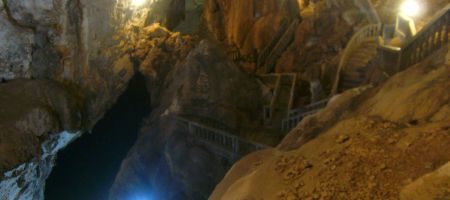Muddy Roads
Being a geographically big but scarcely populated and otherwise quite agrarian country, Laos has not much to offer for the sightseeing tourist.
The few towns there are, are all in the relative lowland, glued to the riverbank of the Mekong river which for the major part forms the boundary between Thailand and Laos. The town centres are all surprisingly compact.
The rest of the country is mostly mountains, jungle or both.
So apart from taking in the relaxed city centres in their colonial atmosphere, what makes Laos appealing to visit is it’s vast untouched nature, and in terms of sights, natural wonders like waterfalls, caves and the like.
And so the most impressive caves I have seen so far have all been in Laos.
Getting there is part of the adventure as (local) public transportation is somewhat scarce or inaccessible. For most caves, an own vehicle is essential.
Whenever I rented a motorbike in Laos, it was always the above model, a 4-geared Chinese-made clone of the popular and reliable Honda Wave that apparently only costs half of what the Honda costs. Well, I actually can’t say anything about the reliability of the Wave but it can be only more reliable than the Zongshen version: Each time I rented this model I found out that something was not working right. One time it was the light, clutch (just needed more force to change) and speedometer1, another time it was the fuel tank display and the rear break (wouldn’t loosen after braking). But I am not complaining, for thirty to fifty thousand kip a day (3-5€) I don’t expect they rent out anything better maintained than what normally goes on the streets in Laos.
By the way: Honda Wave and the like are not scooters. The most important differences being that they have gears (semi-automatic), that you sit on it like on a motorbike (left foot changes gears, right foot is the rear brake) and that they have better suspension with proper sized wheels which makes them eligible for the countryside. This motorbike design seems to be utterly unknown in Germany, closest relatives are the mopeds or mokicks, while on the other hand, the standard motorbike design we know is quite rare here.
So, there are a couple of caves near Tha Khaek, though I had to learn that most are not accessible during rain season (end of September). Well, at least not with a motorbike – perhaps with a 4WD.
Except for the most important national “highways”2, most of the roads in Laos are dirt tracks or compacted roads. Needless to say they can become so muddy during rain season that they are rendered unusable for anything more civilian than Landrovers and the like.
For half an hour or so I had to go through this section of an otherwise good compacted road en route to “Buddha Cave”. (It feels as if half of the caves in Laos do have this name.)
Another obstacle are rivers. Just 50 metres in front of where I took this photo, a sign said “Elephant cave this way, 300m”. Most (all?) fords are not accessible during rain season. (Also, it feels like the other half does have this name ;-))
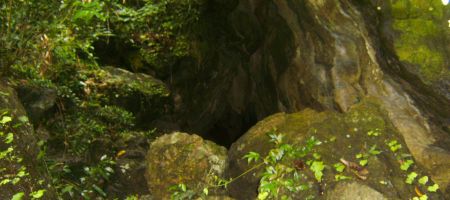
Speaking of rivers: I couldn’t get into this cave because the water flowing out of this cave was too high.
Finally at a cave that I could access, a view to the entrance. This kinda reminds me of a particular loader screen for Clonk Rage.
This cave is quite developed, but that’s okay. There are enough others that are left untouched and for this cave, it really adds to the atmosphere. Below is an underground river, but the tide was too high to get to the boats. Rain season.
Stay tuned for the second part of this article!
1 Not implying that 90% of all speedometers in Laos are not broken anyway.
2 Even though they call it highway, for me, a non-segregated road that has only one lane in each direction with foodstalls, pedestrians and bicycles occupying the sides of it does not qualify as a highway.

